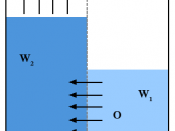An Experiment to investigate Osmosis in Plant Cells
Aim
The aim of this experiment is to investigate the movement of water by osmosis in and out of plant cells across a semi permeable membrane in sucrose solutions of different concentrations. The plant cells used in the experiment are potato and Chinese radish tissues that are used as chips because the results and changes are easy to note and record in this way. As plant cell membranes are differently permeable, different results are expected from the Chinese radish and potato chips in the same conditions; this is one reason for having two types of plant cell and not one. Another reason is that the two types of plant cells results can be compared and the similarities between certain results compared.
The results taken during the experiment can be used to work out information that will help further our understanding of how osmosis takes place in different plant cells (potato and radish), what physical and biological change may take place, and link certain factors presented in our results to prove information useful to the investigation.
Such a point would be to work out at what concentration equilibrium takes place in the chips and how length, mass and concentration affect the results of osmosis (e.g. Flacid, Plasmalysed etc.), and how to link physical results such as if a potato chip floats or sinks to the mass of a potato chip and the concentration of the solution it was in.
Using the results recorded during the experiment, the cell sap sucrose concentration of each chip can be worked out.
Overall, the experiment must be planned and osmosis in plants researched so as to predict what should happen in each of the situations presented in the method.
The experiment taking place and recorded in the...


